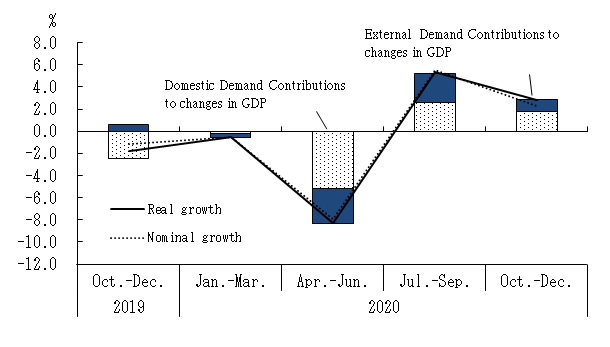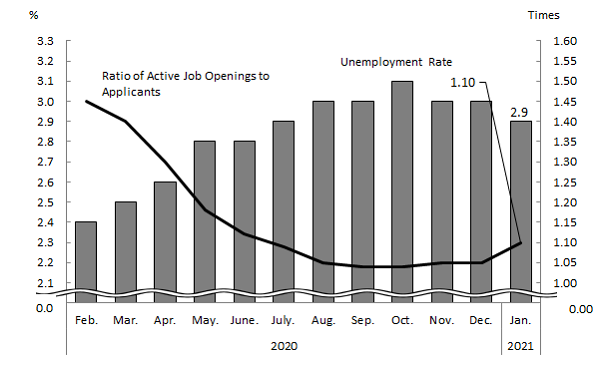Recent Statistical Survey Reports, February 2021
Statistical Survey Reports
Survey on Public Assistance Recipients (November)
February 3, released by the Ministry of Health, Labour and Welfare
The number of welfare recipients in November was 2,048, 675 and the number of households of welfare recipients was 1,636,411.
Survey on Employment Trends (2020)
February 3, released by the Ministry of Health, Labour and Welfare
The hiring rate (the ratio of hired employees to regular employees at the beginning of the new year) was 8.5% and the separation rate (the ratio of separated employees to regular employees at the beginning of the new year) was 8.5%.
Indexes of Business Conditions December 2020 (Preliminary Release)
February 5, released by the Cabinet Office
The Coincident Index of Composite Index (CI, revised figures, 2015=100) in December was 87.8, a decrease of 1.2 point. And 3 months backward moving average increased by 1.00 point, and 7 months backward moving average increased by 2.30 point. So the Assessment of Coincident Index was “Halting to fall” (The same as the previous month).
The Leading Index was 94.9, a decrease of 1.2 point, and the Lagging Index was 91.7, an increase of 0.7 point.
Family Income and Expenditure Survey (December, 2020 Yearly Average)
February 5, released by the Ministry of Internal Affairs and Communications![]()
The average monthly income for a worker’s households with 2 or more family members was down 1.3% in real terms from the previous year. The change over the year of wages & salaries was-2.2% in real terms from the previous year (household heads: -3.7% in real terms, spouse of household: 1.5% in real terms).
The average of consumption expenditures for a worker’s household with 2 or more family members was down 2.0% in real terms from the previous year. The yearly average of monthly income per household for a worker’s household with 2 or more family members was up 4.0% in real terms from the previous year.
The yearly average of monthly consumption expenditures per household was down 5.6% in real terms from the previous year.
Monthly Labour Survey (Provisional Report in December and 2020)
February 9, released by the Ministry of Health, Labour and Welfare![]()
Total amount of cash earnings decreased by 3.2% and contractual cash earnings decreased by 0.8% (full-time employees -0.9%, part-time employees -1.4%) from a year earlier.
Special cash earnings decreased by 5.4% from a year earlier. Scheduled cash earnings decreased by 0.1% and non-scheduled cash earnings decreased by 8.9% from year earlier. Real wage (total cash earnings) decreased by 1.9% from a year earlier and real wage (contractual cash earnings) increased by 0.6% from a year earlier.
Non-scheduled hours worked decreased by 7.6% from a year earlier.
Non-scheduled hours worked by manufacturing industry workers increased by 2.5% from the previous month (seasonally adjusted).
Total amount of cash earnings in 2020 decreased by 1.2% and contractual cash earnings decreased by 0.7% (regular employees -1.1%, part-time workers -0.9%) from a year earlier.
Special cash earnings decreased by 3.7% from a year earlier. Scheduled cash earnings increased by 0.2% and non-scheduled cash earnings decreased by 12.1%. Real wage (total cash earnings) decreased by 1.2% and real wage (contractual cash earnings) decreased by 0.7% from the previous year.
Non-scheduled hours worked decreased by 13.2% from a year earlier.
General Survey on Diversified Types of Employment 2020
February 12, released by the Ministry of Health, Labour and Welfare
National Accounts (The 1st Preliminary Estimates Oct.-Dec.2020)
February 16, released by the Cabinet Office![]()
Real GDP (Gross Domestic Product) growth rate (Seasonally Adjusted) at Oct.-Dec.2020 was 3.0% (12.7% on annual basis). Of real GDP growth rate, 2.0% was contributed by domestic demand and 1.0% by external demand.
Compensation of Employees (real) was 0.8% and compensation of Employees (nominal) was 0.3% (changes from the previous quarter (seasonally adjusted)).
Quartely Estimates of GDP: Oct. ~Dec. 2020 (The 1st Preliminary Estimates)
Growth rate of GDP from the previous Quarters(seasonally adjusted)
Contributions of Domestic Demand and External Demand to Changes in GDP

Labor Force Survey: Detailed Tabulation (Oct.-Dec. 2019 and 2020)
February 16, released by the Ministry of Internal Affairs and Communications
Of the total 56.38 million employee (excl. executive of company or corporation) (average, in the Oct. - Dec. 2020), the number of the regular employees increased by 140 thousand from the previous year to 35.28 million and the number of non-regular employees was 21.09 million, decreased by 780 thousand from the previous year.
Of the total 56.20 million employee (excl. executive of company or corporation) (average, in 2020), the number of the regular employees increased by 350 thousand from the previous year to 35.29 million and the number of non-regular employees was 20.90 million, decreased by 750 thousand from the previous year.
Consumer Price Index Japan (January)
February 19, released by the Ministry of Internal Affairs and Communications
The consumer price index for Japan in January 2021 was 101.6(2015=100), down 0.6% over the year. All items, less fresh food, the comprehensive index was 101.4, down 0.6% from the previous year. All items, less fresh food and energy, the comprehensive index was 102.0, up 0.1% from the previous year.
Monthly Labour Survey (Final Report in December and 2020)
February 24, released by the Ministry of Health, Labour and Welfare![]()
Total amount of cash earnings decreased by 3.0% and contractual cash earnings decreased by 0.7% (full-time employees -0.9%, part-time employees -1.4%) from a year earlier.
Special cash earnings decreased by 5.1% from a year earlier. Scheduled cash earnings decreased by 0.1% and non-scheduled cash earnings decreased by 8.6%. Real wage (total cash earnings) decreased by 1.7% from a year earlier and real wage (contractual cash earnings) increased by 0.7% from a year earlier.
Non-scheduled hours worked decreased by 7.6% from a year earlier.
Non-scheduled hours worked by manufacturing industry workers increased by 2.5% from the previous month (seasonally adjusted).
Total amount of cash earnings in 2020 decreased by 1.2% and contractual cash earnings decreased by 0.7% (regular employees -1.1%, part-time workers -0.9%) from a year earlier.
Special cash earnings decreased by 3.6% from a year earlier. Scheduled cash earnings increased by 0.2% and non-scheduled cash earnings decreased by 12.1%. Real wage (total cash earnings) decreased by 1.2% and real wage (contractual cash earnings) decreased by 0.7% from the previous year.
Non-scheduled hours worked decreased by 13.2% from a year earlier.
Survey on Supply and Demand of Construction Labor
February 25, released by the Ministry of Land, Infrastructure, Transport and Tourism
Indexes of Business Conditions December 2020(Revision of the Preliminary Release)
February 25, released by the Cabinet Office
The Coincident Index of Composite Index (CI, revised figures, 2015=100) in December was 88.3, a decrease of 0.7 point. And 3 months backward moving average increased by 1.17 point, and 7 months backward moving average increased by 2.37 point. So the Assessment of Coincident Index was “Halting to fall” (The same as the previous month)
The Leading Index was 95.3, a decrease of 0.8 point, and the Lagging Index was 90.8, unchanged.
Indices of Industrial Production (January)
February 26, released by the Ministry of Economy, Trade and Industry![]()
The index of industrial production (seasonally adjusted, 2015=100) increased by 4.2% from the previous month. According to the Survey of Production Forecast in Manufacturing, Production is expected to increase in February and decrease in March.
Labour Force Survey (January)
March 2, released by the Ministry of Internal Affairs and Communications
The unemployment rate (seasonally adjusted) was 2.9%, decreased by 0.1 point from the previous month. That for men was 3.2%, unchanged from the previous month and that for women was 2.6%, decreased by 0.2 point from the previous month.
The number of unemployed persons (seasonally adjusted) was 2.03 million, decreased by 70 thousand from the previous month. The number of employees was 59.73 million, decreased by 440 thousand from the previous year.
Among them, the number of regular employee was 35.52 million, increased by 360 thousand from the previous year and the number of non-regular employee was 20.58 million, decreased by 910 thousand from the previous year.
Employment Referrals for General Workers (January)
March 2, released by the Ministry of Health, Labour and Welfare![]()
Active job openings-to-applicants ratio (seasonally adjusted) was 1.10, increased by 0.05point from the previous month.
The number of monthly active job openings (person(s)) (seasonally adjusted) was increased by 3.1% from the previous month and the number of monthly active applications (person(s)) (seasonally adjusted) was decreased by 2.3% from the previous month.
New job openings-to-applicants ratio (seasonally adjusted) was 2.03, decreased by 0.08 point from the previous month.
Active job openings-to-applicants ratio for regular staff (seasonally adjusted) was 0.79, increased by 0.02 point from the previous month.
Trend in Unemployment Rate and Ratio of Active Job
Openings to Applicants (seasonally adjusted)

Other Reports
Monthly Economic Report (February)
February 19, released by the Cabinet Office![]()
The Japanese economy shows weakness in some components although it remains in picking up in a severe situation due to the Novel Coronavirus. (In the previous month, “The Japanese economy is still in a severe situation due to the Novel Coronavirus, but it is showing movements of picking up.”)
- Private consumption has been in a weak tone recently. (In the previous month, “Private consumption appears to be pausing for picking up.”)
- Business investment is showing movements of picking up recently. (In the previous month, “Business investment is starting to level off.”)
- Exports are increasing. (The same as the previous month.)
- Industrial production is picking up. (The same as the previous month.)
- Corporate profits are picking up as a whole, while weakness is seen in non-manufacturers due to the influence of the infectious disease. Firms' judgments on current business conditions show cautiousness recently, mainly among non-manufacturers. (In the previous month, “Corporate profits are decreasing substantially due to the influence of the infectious disease, but the rate of decline is becoming smaller as a whole. Firms' judgments on current business conditions show cautiousness recently, mainly among non-manufacturers.”)
- Employment situation shows steady movements in some components such as the number of employees, while weakness remains, due to the influence of the infectious disease. (The same as the previous month.)
- Consumer prices are flat. (The same as the previous month)
| To view PDF files, you will need Adobe Acrobat Reader Software installed on your computer.The Adobe Acrobat Reader can be downloaded from this banner. |

